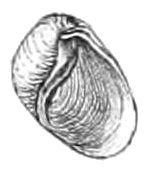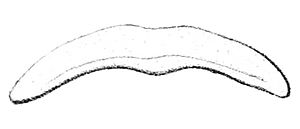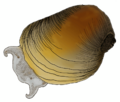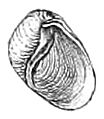Newcomb's snail facts for kids
Quick facts for kids Newcomb's snail |
|
|---|---|
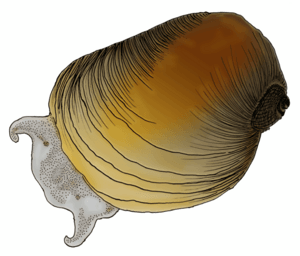 |
|
| Drawing of Erinna newcombi. | |
| Conservation status | |
| Scientific classification | |
| Kingdom: | |
| Phylum: | |
| Class: | |
| (unranked): | |
| Superfamily: |
Lymnaeoidea
|
| Family: |
Lymnaeidae
|
| Genus: |
Erinna
|
| Species: |
E. newcombi
|
| Binomial name | |
| Erinna newcombi H. Adams & A. Adams, 1855
|
|
The Newcomb's snail (Erinna newcombi) is a special kind of freshwater snail that breathes air. It's a mollusk, like a slug or an oyster, and belongs to the Lymnaeidae family. This snail lives only in Hawaii, United States. Its natural home is in rivers. Sadly, it's in danger because its habitat is disappearing.
Erinna newcombi is the main example species for its group, called Erinna.
Contents
Discovering Newcomb's Snail
The first Newcomb's snails were found by scientists during the United States Exploring Expedition between 1838 and 1842. These snails were collected around October or November 1840. They were found near "Hanapēpē Falls" on the island of Kauaʻi. Today, this place is likely Manuwaiopuna Falls.
These early snail samples were sent to the British Museum of Natural History. Scientists later used them to describe the species in 1855. The snail's common name and scientific name honor Dr. Wesley Newcomb, who collected them in Hawaii.
The original place where these snails were found was called "Heneta River, Kami, Sandwich Islands." This actually means the Hanalei River on Kauaʻi, Hawaii.
Family Ties: Hawaiian Lymnaeids
Newcomb's snail is one of four types of Lymnaeidae snails that are native to Hawaii. Three of these snail types live on two or more of the main Hawaiian islands. But Newcomb's snail is special because it only lives on the island of Kauaʻi.
Scientists once thought a similar-looking snail from Japan might be related. However, studies of chromosomes show that Newcomb's snail is more closely related to other Hawaiian lymnaeids. These Hawaiian snails all came from ancestors in North America. This means that Newcomb's snail and the Japanese snail developed similar shell shapes on their own, through something called parallel evolution.
Naming the Snail: Erinna newcombi
For a while, scientists weren't sure about the best scientific name for Hawaiian lymnaeid snails. However, Newcomb's snail is now officially known as Erinna newcombi.
Some scientists, like Bengt Hubendick (in 1952), thought Newcomb's snail wasn't different enough to have its own genus (a larger group). He put all Hawaiian lymnaeids into the genus Lymnaea. But Joseph Paul Eldred Morrison (in 1968) disagreed. He said the snail's unique shell features supported the name Erinna. Other scientists, including John B. Burch (1968) and Robert H. Cowie (1995), agreed with Morrison. That's why Erinna newcombi is the name we use today.
What Newcomb's Snail Looks Like
Newcomb's snail is special among Hawaiian lymnaeids because its shell spire is very small. The spire is the pointy top part of a snail shell. This makes its shell look almost smooth.
The shell is usually brown to black and shaped like an oval. It's about 6 millimeters (0.25 inches) long and 3 millimeters (0.12 inches) wide. It has only one main whorl (a turn in the shell).
The shell is thin and looks a bit like horn. It has fine lines running lengthwise. The very tip of the shell, called the apex, is often worn away. The last part of the shell, the body whorl, is swollen. The opening, called the aperture, is large and oval-shaped.
The snail's jaw is low and wide, with a slight curve. It has a small bump in the middle of its cutting edge. The front of the jaw is smooth.

Newcomb's snail has a special tongue-like ribbon called a radula. This radula has many tiny teeth that help the snail scrape food. The central tooth is long and narrow. The side teeth are wide and have three points. The teeth at the edges are wider than they are tall and have five or more blunt points.
Where Newcomb's Snail Lives
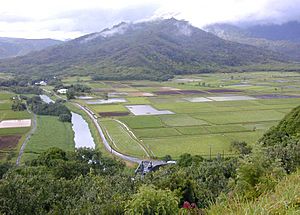
Newcomb's snail is found only on the island of Kauaʻi. This snail is endemic to this island, meaning it lives nowhere else in the world. Kauaʻi has many large watersheds (areas where water drains into a river or stream) in its southeast part. These include Olokele Stream, Hanapēpē Stream, and Waimea River.
It's hard to survey for Newcomb's snails in many areas because they are on private land or in rough terrain. So, it's possible that more snail groups exist in those areas.
Past and Present Locations
Before about 1925, snails were found in streams like Kalalau Stream, Hanakoa Stream, Hanakāpī`ai Stream, Wainiha River, and Keālia Stream. Sadly, the snails in Hanakoa, Hanakāpī`ai, and Wainiha are now thought to be gone.
Since 1993, scientists have found four new groups of Newcomb's snails. These are in the Lumaha`i River, the Hanalei River, Makaleha Stream, and the North Fork Wailua River. Most of these groups have only been seen once or twice. Two snails were also reported in Limahuli Stream, but it's not considered a "population" yet because a stable group hasn't been confirmed there.
Today, Newcomb's snails are known to live in small spots in six watersheds on Kauaʻi. These are Kalalau Stream, Lumaha`i River, Hanalei River (with four smaller groups), Keālia Stream, Makaleha Stream (with two smaller groups), and the North Fork Wailua River. A "subpopulation" is a small group of snails separated from others in the same watershed. They don't move much, so they don't mix with other groups.
We don't have old records of how many Newcomb's snails there used to be. However, reports suggest that the groups in Kalalau Stream and Lumaha`i River are larger than the others.
Snail Life and Environment
Newcomb's snail must live in freshwater. We don't know much about its life, like how long it lives, how it reproduces, or how many eggs it lays.
We do know that Newcomb's snail is active during the day.
What They Eat and How They Live
Newcomb's snails likely live similar lives to other snails in their family. Lymnaeid snails usually eat algae and plants that grow on rocks underwater. They lay their eggs on submerged rocks or plants. The young snails don't travel far. This means their whole life cycle is connected to the stream system where the adult snails live.
We don't know much about what affects the number of Newcomb's snails. Important factors might include changes in stream flows, severe weather, or long periods of drought. Snails probably move up and down streams to find new homes. However, they don't often move between different stream systems because they need freshwater. In the past, major erosion events might have helped them spread to nearby streams.
This is very different from other Hawaiian freshwater snails, like the neritid snails. Neritid snails have young that live in the ocean and then move into streams. Their ocean-dwelling young can travel across the sea between islands. Newcomb's snail cannot do this.
Where They Live: Specific Habitat Needs
Newcomb's snails need fast-flowing perennial streams (streams that flow all year). They also live in springs, seeps, and near waterfalls. They are usually found in areas protected from strong water flows within the main stream channels. This is because strong flows can move rocks and sediment, which can harm the snails.
So, their best homes are in small, spring-fed streams or under waterfalls. These places have steady water, even during dry times. Newcomb's snails live in a narrow range of mid-level elevations, usually around 306 meters (1,005 feet) above sea level. They can be found between 196 and 396 meters (643 to 1,299 feet) high.
Scientists think that four types of introduced caddisfly insects might be harming native water insects, including snails. These caddisflies might compete for food and space, or their large numbers could be a problem.
Who Eats Newcomb's Snail
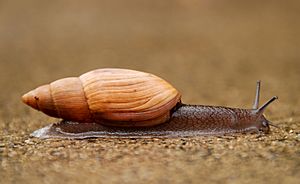
The non-native rosy glandina snail (Euglandina rosea) is a big threat to Newcomb's snail. This snail was brought to Hawaii in 1955 and now lives on many islands. The rosy glandina eats other snails and slugs. It has even been seen diving into water to hunt aquatic snails like Newcomb's snail. This predatory snail has caused many native snails to disappear or even go extinct across the Pacific Islands.
Two non-native sciomyzid flies, the marsh fly (Sepedomerus macropus) and Sepedon aenescens, also threaten Newcomb's snail. These flies eat lymnaeid snails. They were brought to Hawaii in 1958 and 1966 to control another non-native snail. However, they might be harming Newcomb's snail and other native snails instead.
Other introduced animals that might eat Newcomb's snail include the green swordtail fish (Xyphophorus helleri), the American bullfrog (Rana catesbeiana), the wrinkled frog (Rana rugosa), and the cane toad (Bufo marinus).
How Many Snails Are Left?
Based on the six known groups, there are likely about 6,000 to 7,000 Newcomb's snails in total. Most of these, over 90%, live in the Kalalau and Lumaha`i populations. The areas where these snails live are very remote and hard to reach. Three of the six groups can only be visited by helicopter.
Because it's so hard to get to these places, no full count of Newcomb's snails has been done since 1995. So, we don't know how the numbers have changed since then.
The total area where Newcomb's snails live in any one spot is very small. It can be as tiny as 2 square meters (22 square feet) or up to 30 square meters (323 square feet). Because they live in such small areas, they are very vulnerable to sudden disasters. Things like flooding from hurricanes or tropical storms, huge landslides, droughts, or new invasive species could wipe out entire groups of snails.
For example, Hurricane Iniki in 1992 and Hurricane Iwa in 1982 caused a lot of damage on Kauaʻi. These events might have destroyed large areas where Newcomb's snails lived. Any plan to help these snails must consider their spread across the island. This way, separate groups can be protected in different watersheds.
Protecting Newcomb's Snail
Newcomb's snails are still in danger from human changes to Kauaʻi's water systems. These changes include large irrigation projects and farming that take water away from streams and groundwater.
In 1995, before Newcomb's snail was listed as threatened, Kauaʻi County planned a big project. They wanted to take water from Makaleha Springs for homes. This project would have likely wiped out the entire group of Newcomb's snails there. However, the State Commission on Water Resource Management stopped the project. They said it had too many environmental problems, including harm to aquatic life.
Erinna newcombi is listed as a vulnerable species on the 2006 and 2009 IUCN Red List. This means it's at high risk of becoming endangered.
Since January 26, 2000, this snail has been listed as threatened by the United States Fish and Wildlife Service. This happened under the Endangered Species Act of 1973. Because of this, it's also automatically added to the State of Hawaii's list of protected species.
A "Critical habitat" was set aside for Newcomb's snail on August 20, 2002. This is a special area that is very important for the snail's survival. It includes eight stream parts, along with their smaller streams, springs, and nearby areas. This covers 1,812 hectares (4,479 acres) and about 19.76 kilometers (12.28 miles) of stream channel. The critical habitat includes the six places where snails are known to live now. It also includes two places where snails were seen in the past but are now thought to be gone (Hanakoa Stream and Hanakāpī`ai Stream).
Newcomb's snail is the first and only freshwater animal in Hawaii to be listed as threatened under Federal and State law. The Hawaii Department of Land and Natural Resources is working to research and manage rare water species like Newcomb's snail. They are working with endangered species experts to create a plan to protect Newcomb's snail. So far, no specific conservation actions have been put into place.
Images for kids
-
Drawing of extreme marginal teeth (on the left), marginal teeth (in the center of the image), and central and lateral teeth (on the right) of radula of Newcomb's snail.
-
Hanalei River, where the Newcomb's snail lives
-
The glandina snail Euglandina rosea is one of the known predators of the Newcomb's snail
See also
 In Spanish: Erinna newcombi para niños
In Spanish: Erinna newcombi para niños



